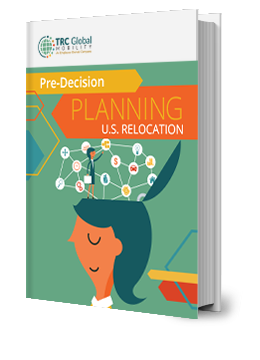
 Getting Started: The Initial Needs Assessment
Getting Started: The Initial Needs Assessment
The first phase of an effective pre-decision planning program is an initial needs assessment. The initial needs assessment typically consists of a brief, pre-initiation call or interview to gather key financial and lifestyle details on the employee and his or her family. These details should include information on:
- The family’s current home and finances
- The spouse or partner’s current employment situation
- Expectations and requirements for the spouse or partner’s employment in the new location
Ideally, this interview is conducted by a third-party relocation consultant rather than a representative from the company. Employees might be reticent about sharing personal details with a coworker, and company representatives might not be sure which questions to ask to get a full picture of the transferee’s situation.
To prevent surprises and encourage complete and candid responses, potential transferees should know that the call is coming, as well as the purpose of the call. The consultant should emphasize that the initial needs assessment is not an initiation call, an offer of the position, or a commitment to offer any specific benefits.
Identifying Real Estate Considerations and Home Valuation
For most employees, their real estate situation will be pivotal in the decision-making process. Given this, it is critical to determine the market value of the home (and the state of the market, including the projected sale timeframe) before relocation is offered. (Many companies incorporate a mortgage pre-approval process at this stage, to confirm the employee would qualify for a mortgage and to determine the amount he or she would have available to spend at the destination.)
In the needs assessment conversation, the consultant will begin to determine three key real estate factors:
- What the employee paid for his or her home
- The current mortgage balance
- Whether the employee plans to purchase a home at the destination
Not surprisingly, home value information from the employee is seldom accurate or useful in making a business decision. Many people overestimate their home’s value, creating unrealistic expectations of the sale price and the length of time needed for a sale. A true assessment of the employee’s financial position requires a more detailed analysis of the departure home and its value — an analysis which the relocation management company should be able to provide to the employer in a summary report. This analysis can be accomplished in at least three ways, listed below in increasing order of accuracy, complexity and cost:
- Online services such as Zillow and Trulia (preferably more than one, since results tend to vary)
- A broker market analysis (BMA) by a capable agent. This data invariably provides a more complete picture that can make the potential transferee’s position much clearer and alerts the employer if supplemental services (and costs) might be required to complete the relocation. BMAs do add time to the process — perhaps a week — and the employee response deadline must be long enough to allow this analysis to be completed and for both sides to assess the results.
- An appraisal. An appraisal will accomplish the same objective as a BMA, with even more objective and detailed data to support the established value. However, appraisals cost more and take longer than BMAs, and the additional information gleaned might be overkill for a pre-decision program. Some companies generally use BMAs but reserve appraisals for more difficult property valuations.
Summary Report and Follow-Up
With all of this information captured, the relocation company will prepare and present a summary analysis of the employee’s situation to the company. This report should be customized to reflect the company’s specific requirements. For relatively straightforward and less costly employee relocations, this report might be sufficient, though the consultant should always be available to clarify or discuss the information in more detail.
If the relocation looks like it will be complex and costly; if the employee has unusual needs; or if the employee expresses reservations about relocating, a company representative likely will want to discuss the move in detail. At this point, the company might cancel or postpone the relocation or the employee might opt out. These canceled relocations may transition into commuter or hybrid assignments, either permanently or until a formal relocation becomes practical.
If the employer and employee decide the relocation makes sense, the relocation process proceeds, and a look-see trip can be scheduled. The consultant or a relocation specialist schedules an initiation call to formally begin the relocation process. He or she re-introduces the program and explains the benefits for which the employee is eligible.
If the employee agrees to the move and the company is using a classic tiered relocation policy model (based on job level, salary or other factors), it will be simple to identify the applicable policy and the estimated costs of these standard policy components and any exceptions. Companies that use the increasingly popular core/flex model or that have a permissive exception culture will need to tailor the relocation package to meet the employee’s identified needs. Then they can estimate the total cost of the package required to complete the relocation. Some items might be negotiable among the hiring manager, HR or relocation managers and the candidate.
Closing the Loop
Pre-decision programs provide more and better data to estimate costs, but it’s important for the employer to remember that the cost projections are still estimates. In addition, some costs, such as possible loss-on-sale benefits, are difficult or impossible to estimate until the relocation process is underway. Still, the pre-decision process can reduce the likelihood of unpleasant surprises and pave the way for smoother, more successful transitions. Given the cost and complexity of a typical relocation, pre-decision programs represent a valuable talent management tool.
 Want to Learn More about Pre-Decision Planning?
Want to Learn More about Pre-Decision Planning?
Download the White Paper.
In this white paper, you’ll learn:
 Want to Learn More about Pre-Decision Planning?
Want to Learn More about Pre-Decision Planning?



